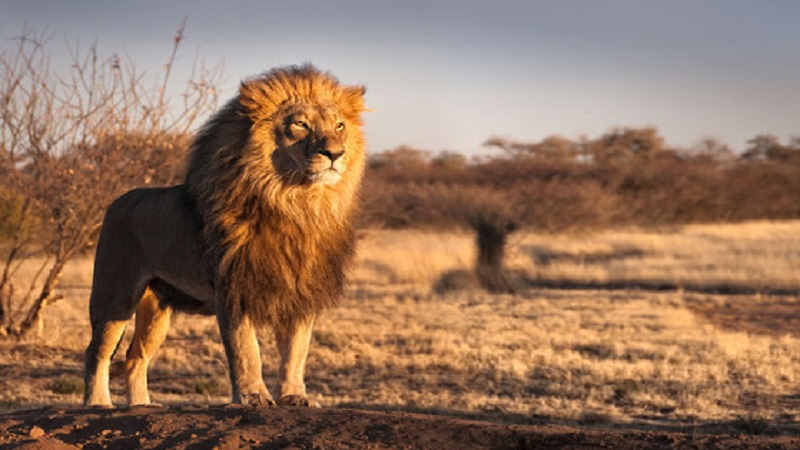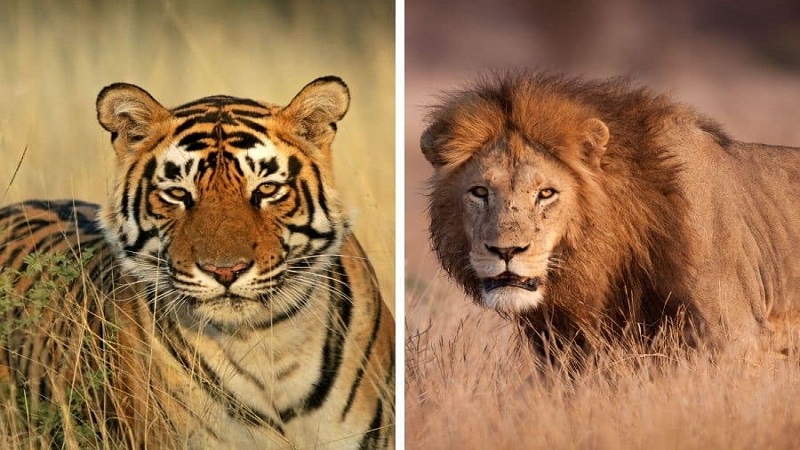Lions and tigers are two of the most powerful and awe-inspiring predators in the animal kingdom. Their raw strength, agility, and majestic presence have fascinated humans for centuries. But the question that has always intrigued wildlife enthusiasts and casual observers alike is: If a lion and tiger got into a fight, who would win? In this article, we will explore the characteristics, strengths, and weaknesses of both animals and analyze which one would likely emerge victorious in such a rare encounter.
Physical Characteristics of Lions
Size and Weight of Lions
Lions, known as the “Kings of the Jungle,” are incredibly powerful animals. Adult male lions typically weigh between 330 to 550 pounds (150 to 250 kg) and can measure up to 10 feet (3 meters) from head to tail. Female lions are slightly smaller but still formidable. Their muscular bodies and large paws make them capable of taking down large prey, such as zebras, buffalo, and even giraffes.
Social Structure of Lions
Lions are social creatures that live in groups called prides. This social structure allows them to hunt together and protect their territory more efficiently. The bond between pride members strengthens their teamwork and overall survival. However, in a one-on-one fight, a lion will not have the advantage of its pride and must rely solely on its own abilities.
Physical Characteristics of Tigers
Size and Weight of Tigers
Tigers, especially the Siberian tiger, are larger than lions, weighing between 400 to 660 pounds (180 to 300 kg) and measuring up to 12 feet (3.6 meters) from head to tail. They have a more robust build, with powerful muscles designed for stealth and strength. Tigers are solitary animals, and their size is often larger due to the lack of competition for resources from other members of their species.
Hunting Style of Tigers
Tigers are solitary hunters and rely heavily on ambush tactics to take down their prey. Their strength is in their stealth, speed, and precision. A tiger will stalk its prey patiently, waiting for the perfect moment to strike with a powerful leap. This method of hunting requires extreme strength and agility, both of which are vital in a fight with a lion.
Strengths of Lions
The Power of a Lion Mane
The lion’s mane is more than just a symbol of its majesty. It also serves as a form of protection in fights. The thick fur around a male lion’s neck can absorb blows and bites, giving the lion a significant defensive advantage. In a fight with a tiger, the lion’s mane could prove critical in shielding it from fatal injuries.
Fighting Experience
Because lions often engage in battles to defend their territory or compete for dominance within their pride, they are more accustomed to fighting. This experience gives them an edge in confrontations, as they are trained to defend and attack in combat. In a hypothetical fight between a lion and tiger, the lion’s fighting experience would likely play a significant role in determining the outcome.

Strengths of Tigers
Raw Power of Tigers
Tigers possess a raw, muscular power that is unmatched by many predators. Their forelimbs are particularly strong, allowing them to swipe with great force. In terms of sheer muscle mass, tigers have a slight edge over lions. This raw power would be an asset in any fight with a lion, allowing the tiger to deliver crushing blows that could quickly turn the tide of battle.
Agility and Stealth
While lions are powerful, tigers are more agile. They can leap great distances and move with an astonishing level of precision. Their solitary nature has made them adept hunters, requiring them to rely on stealth and quick reflexes. In a one-on-one fight, the tiger’s ability to move swiftly and strike suddenly could give it a distinct advantage over the lion.
Comparing Combat Skills
Lion Endurance vs. Tiger Strength
When discussing who would win if a lion and tiger got into a fight, endurance versus strength becomes a significant factor. Lions are known for their endurance, often engaging in long fights, while tigers, being ambush predators, rely more on short bursts of power. A prolonged battle might favor the lion due to its stamina, but a quick, brutal encounter could tilt the scales in the tiger’s favor due to its immense strength.
Bite Force Comparison
Both lions and tigers have incredibly powerful jaws, but tigers have a stronger bite force. A tiger’s bite can exert up to 1,050 pounds per square inch (psi), compared to a lion’s 650 psi. In a close-range fight, the tiger’s stronger bite could inflict more damage and potentially lead to a quicker victory.
Habitat and Behavior Differences
Lions in Open Savannas
Lions thrive in open savannas and grasslands, where they can see long distances and rely on their pride to help hunt. Their environment encourages cooperative hunting and defense. In a fight, a lion would be more comfortable in open spaces, where its experience in territorial battles comes into play.
Tigers in Dense Jungles
On the other hand, tigers inhabit dense jungles, where their solitary nature and stealth are necessary for survival. In a jungle setting, a tiger would have the advantage of cover and could use its ambush tactics more effectively in a fight.
Historical Encounters Between Lions and Tigers
Documented Cases of Lion-Tiger Fights
Throughout history, there have been rare instances where lions and tigers have fought, particularly in captivity. In some of these encounters, tigers have emerged victorious, but there have also been cases where lions have won. The outcome often depends on individual circumstances, such as size, age, and fighting experience.

Hypothetical Scenarios: Who Would Win?
If a Lion and Tiger Got into a Fight, Who Would Win?
So, if a lion and tiger got into a fight, who would win? This question has no simple answer. Both animals have unique strengths that make them formidable opponents. In a one-on-one confrontation, the outcome could go either way, depending on the circumstances of the fight. The lion’s endurance and experience could give it an edge in a prolonged battle, while the tiger’s raw power and agility might lead to a swift victory in a quicker fight.
Factors That Could Influence the Outcome
Several factors could influence the outcome of a fight between a lion and a tiger, including:
- The size and age of the animals
- The location of the fight (open space or dense jungle)
- Whether the animals are well-fed or hungry
- The experience of each animal in previous fights
Conclusion
In the age-old debate of if a lion and tiger got into a fight, who would win, there is no definitive answer. Both lions and tigers are apex predators with their own set of advantages and disadvantages. While lions may have more experience in fighting due to their social structure, tigers are solitary hunters with raw power and agility on their side. Ultimately, the outcome of such a fight would depend on various factors, making it an exciting yet unpredictable encounter.
FAQs
1. Who is stronger, a lion or a tiger?
Tigers are generally stronger than lions in terms of muscle mass and bite force. However, lions have more experience in fighting due to their social nature.
2. Have lions and tigers ever fought in real life?
Yes, there have been rare cases of lions and tigers fighting, particularly in captivity. The results of these fights have varied, with both species winning in different instances.
3. Are lions and tigers natural enemies?
No, lions and tigers do not typically encounter each other in the wild, as they inhabit different regions. Lions live in Africa, while tigers are found in Asia.
4. Can lions and tigers breed together?
Yes, lions and tigers can breed in captivity to produce hybrids known as ligers (male lion, female tiger) or tigons (male tiger, female lion).
5. Which animal is more endangered, the lion or the tiger?
Both lions and tigers are vulnerable species, but tigers are more endangered due to habitat loss and poaching, with fewer individuals remaining in the wild.
